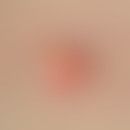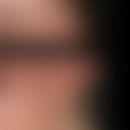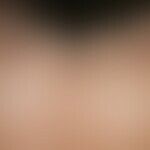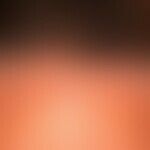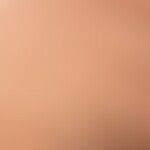Synonym(s)
HistoryThis section has been translated automatically.
S. Kossard, 1994
DefinitionThis section has been translated automatically.
"Postmenopausal", circumscribed, band-shaped, symmetrical, fibrosing form of scarring alopecia (irreversible) in the frontotemporal hairline in women with lymphoid-histiocytic infiltrates around the hair follicles. Often associated with rarefaction of the eyebrows. Men suffer less frequently from this clinical picture. This form of chronic creeping alopecia is often accompanied by keratosis pilaris, which is clinically conspicuous in adolescence and early adulthood.
The Frontal Fibrosing Alopecia - FFA Severity Index is used for the standardized assessment of the severity of the clinical picture. The score includes spread, involvement of body and facial hair, skin involvement, mucous membrane and nail involvement.
If >/= 4 points with typical criteria for frontal fibrosing alopecia, the diagnosis must be made. The frontal recession of the frontal hairline with loss of hair follicle ostia counts for 2 points, the positive biopsy in one of the affected areas: frontal or temporal scalp area or eyebrows also counts for 2 points, 1 point each for the loss of at least 50 % of the eyebrows and 1 point for follicular erythema on the frontal scalp, also 1 point for perifollicular scalp hyperkeratosis or dandruff on the frontal scalp.
You might also be interested in
Occurrence/EpidemiologyThis section has been translated automatically.
Almost exclusively women. In a larger collective, about 3-5% men were described.
EtiopathogenesisThis section has been translated automatically.
Unexplained. A variant of lichen planopilaris or a partial manifestation of a so-called keratosis rubra-pilaris syndrome is being discussed.
ManifestationThis section has been translated automatically.
Beginning of clinically noticeable symptoms between 56 and 60 years of age (in a larger collective, the mean age at the time of diagnosis was 61 years, ranging from 23 - 86 years).
ClinicThis section has been translated automatically.
Band-like, frontal or frontotemporal also exclusively temporal hairlessness (alopecia). The clinical presentation ranges from mild, grade I (anterior hairline recession of <1.0cm) to grade V (anterior hairline recession of >7 cm). The grade V condition is also referred to as "clown alopecia." No hair follicles are detectable in the affected areas. Discrete perifollicular redness or follicular keratotic papules are found in the adjacent hair area. Mostly imperceptible onset without subjective symptoms (especially no itching): Receding frontal hairline, spreading to parietal - and occipital region. Effluvium is usually not noticed. The disease only becomes evident when the chronic creeping receding of the frontal or temporal hairline becomes conspicuous (picture comparison with earlier). Skin in the affected areas is clearly lighter, less tanned. Usually single hairs (lonely hairs) remain in these atrophy areas.
Associated diseases: In most cases, alopecia is accompanied by ullerythema ophryogenes as well as keratosis pilaris simplex (Note: Often, associated simple keratosis pilaris is no longer noticed, since it is no longer present in its typical form at the advanced age of the patient. (Remark: Often an associated simple keratosis pilaris is not perceived anymore, because in the advanced age of the patient it does not appear in its typical expression (rubbing iron skin) but only "as not disturbing but rather welcome, hairless, smooth surfaces" of the extensor extremities: no hair at all at the extensor sides of the forearms).
Clinically, 3 different patterns of regression of the forehead-hair boundary are distinguished:
- Type I: Band-like
- Type II: further foci of alopecia behind the forehead-hair boundary
- Type III: preserved frontal hairline, band-like pattern behind it (pseudo-fringe sign).
HistologyThis section has been translated automatically.
Differential diagnosisThis section has been translated automatically.
- Clinical:
- Graham-Little-Lasseur syndrome: variant of lichen planus follicularis with follicular, lacy keratotic lesions on the trunk, the typical clinical and histologic signs of lichen planus, and scarring alopecia. Nail dystrophies are possible. No ulerythema; no keratosis pilaris.
- Lichen planus follicularis capillitii: Minus variant of lichen planus follicularis. Otherwise see before!
- Alopecia marginalis: Reversible, mechanically caused hair loss due to chronic traction, e.g. with tight hairstyle. Traction alopecia with corresponding history and clinic. No follicular inflammatory signs.
- Alopecia androgenetica: Absence of any follicular inflammatory phenomena as characteristic of fibrosing alopecia and lichen planus follicularis.
- Alopecia areata: The type and duration of the "continuously receding hairline" is completely atypical of alopecia areata.
- Chron. discoid lupus erythematosus: The morphologic pattern of fibrosing alopecia is atypical for CDLE. Usually evidence of other active or scarred lesions.
- Histologic:
- Lichen planus follicularis capillitii: lichenoid infiltrate pattern perifollicularly, on the surface epithelium signs of interface dermatitis. This is completely absent in fronatal fibrosing alopecia.
- Chronic discoid lupus erythematosus: Interface dermatitis, immmunhistological differentiation with deposits of immunoglobulins at the dermo-epidermal junctional zone.
TherapyThis section has been translated automatically.
General therapyThis section has been translated automatically.
Trial with minoxidil solution. Antiandrogens such as finasteride were successful in half of the patients treated in this way. The most successful therapy with > 62 % proved to be the therapy with dutasteride®. Remark: these therapeutic successes are doubted by the author of this article!
Radiation therapyThis section has been translated automatically.
Internal therapyThis section has been translated automatically.
Trial with oral retinoids .
Notice. Look for lichen planus stigmata! Finasteride 2.0-5.0 mg/day p.o. Systemic therapies include 5-alpha-reductase inhibitors, hydroxychloroquine, and retinoids. In isolated cases, success has been described with glucocorticosteroids, ciclosporin A, azathioprine, thalidomide, mycophenolate mofetil.
Progression/forecastThis section has been translated automatically.
Note(s)This section has been translated automatically.
The entity of the clinical picture remains controversial.
Probably partial manifestation of the keratosis pilaris syndrome(ulerythema ophryogenes, keratosis pilaris, alopecia).
It can be assumed that the clinical picture also occurs in men, but is not diagnosed due to the superimposed androgenetic alopecia.
LiteratureThis section has been translated automatically.
- Banka N et al. (2014) Frontal fibrosing alopecia: a retrospective clinical review of 62 patients with treatment outcome and long-term follow-up. Int J Dermatol 53:1324-1330
- Boms S, Gambichler T (2005) Postmenopausal frontal fibrosing alopecia (Kossard) Akt Dermatol 31: 30-32
- Kossard S (1994) Postmenopausal frontal fibrosing alopecia. Arch Dermatol 130: 770-774
- Kossard S, Lee MS, Wilkinson B (1997) Postmenopausal frontal fibrosing alopecia: a frontal variant of lichen planopilaris. J Am Acad Dermatol 36: 59-66
- MacDonald A et al. (2012) Frontal fibrosing alopecia: a review of 60 cases. J Am Acad Dermatol 67:955-961
Nutz MC et al. (2025) Line-field confocal optical coherence tomography in lichen planopilaris and frontal fibrosing alopecia: A pilot study. J Dtsch Dermatol Ges 23:173-181.
Pérez-Rodríguez IM et al. (2013) Hyperpigmentation following Treatment of Frontal Fibrosing Alopecia. Case Rep Dermatol 23:357-362
- Samrao A et al. (2010) Frontal fibrosing alopecia: a clinical review of 36 patients. Br J Dermatol 163:1296-1300
- Tosti A et al. (2004) Frontal fibrosing alopecia in postmenopausal women. J Am Acad Dermatol 52: 55-60
- Tremezaygues L et al (2012) Frontal fibrosing alopecia with androgenetic pattern. Dermatology 63: 411-414
- Vañó-Galván S et al.(2014)Frontal fibrosing alopecia: a multicenter review of 355 patients. J Am Acad Dermatol 70:670-678
- Wagner G et al.(2016) Frontal fibrosing alopecia Kossard. Dermatologist 67:891-896.
- Blume-Peytavi U et al. (2022) Frontal fibrosing alopecia - current knowledge. Dermatologist 73: 344-352
- Pindado-Ortega C et al. (2021) Effectiveness of dutasteride in a large series of patients with frontal fibrosing alopecia in real clinical practice. J Am Acad Dermatol. 84: 1285-1294
Incoming links (7)
Alopecia androgenetica in women; Finasteride; Lichen planopilaris; Madarosis; Postmenopausal frontal fibrosing alopecia; Ppfa; Ulerythema ophryogenes;Outgoing links (14)
Alopecia androgenetica in women; Alopecia areata (overview); Alopecia marginalis; Alopecia (overview); Dutasteride; Finasteride; Keratosis pilaris; Keratosis pilaris; Lichen planopilaris; Lichen planus follicularis; ... Show allDisclaimer
Please ask your physician for a reliable diagnosis. This website is only meant as a reference.
